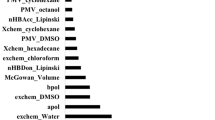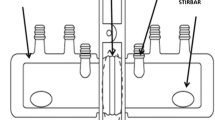Abstract
The parallel artificial membrane permeation assay (PAMPA) was developed as a model for the prediction of transcellular permeation in the process of drug absorption. In our previous report, it was revealed that PAMPA permeability is governed by log P, pK a, and the hydrogen-bonding ability of compounds. In order to construct a new filtering method for selecting informative compounds from the whole combinatorial library, this study tried to predict PAMPA permeability with in silico descriptors. Log P, pK a, and polar surface areas (PSA) as a hydrogen-bonding descriptor were calculated by commercially available or free-accessible web programs. Five-fold cross-validations and conventional regression analyses were examined with the training set for the entire 81 combinations with nine log P, three pK a and three PSA descriptors. By comparison of statistical indices, four equations were selected and then the model with the best combination of in silico descriptors was determined based on the external validation. The PAMPA prediction equation obtained in this report could be applied for the prediction of both Caco-2 cell permeability and human intestinal absorption of mainly passively-transported drugs.


Similar content being viewed by others
References
Lipinski CA, Lombardo F, Dominy BW, Feeney PJ (1997) Adv Drug Deliv Rev 23:3. doi:10.1016/S0169-409X(96)00423-1
Veber DF, Johnson SR, Cheng HY, Smith BR, Ward KW, Kopple KD (2002) J Med Chem 45:2615. doi:10.1021/jm020017n
Lin J, Sahakian DC, de Morais SMF, Xu JJ, Polzer RJ, Winter SM (2003) Curr Top Med Chem 3:1125. doi:10.2174/1568026033452096
Kansy M, Senner F, Gubernator K (1998) J Med Chem 41:1007. doi:10.1021/jm970530e
Sugano K, Hamada H, Machida M, Ushio H (2001) J Biomol Screen 6:189. doi:10.1177/108705710100600309
Sugano K, Takata N, Machida M, Saitoh K, Terada K (2002) Int J Pharm 241:241. doi:10.1016/S0378-5173(02)00240-5
Sugano K, Nabuchi Y, Machida M, Aso Y (2003) Int J Pharm 257:245. doi:10.1016/S0378-5173(03)00161-3
Avdeef A (2003) Absorption and drug development. Wiley-Interscience, New Jersey
Fujikawa M, Ano R, Nakao K, Shimizu R, Akamatsu M (2005) Bioorg Med Chem 13:4721. doi:10.1016/j.bmc.2005.04.076
Fujikawa M, Nakao K, Shimizu R, Akamatsu M (2007) Bioorg Med Chem 15:3756. doi:10.1016/j.bmc.2007.03.040
Ano R, Kimura Y, Shima M, Matsuno R, Ueno T, Akamatsu M (2004) Bioorg Med Chem 12:257. doi:10.1016/j.bmc.2003.10.002
MacLogP 4.0; Biobyte Corp., Claremont
CQSAR 4.31; Biobyte Corp., Claremont
SYBYL Molecular Modeling Software; Tripos Associates Inc., St Louis
Leonard JT, Roy K (2006) QSAR Comb Sci 25:235. doi:10.1002/qsar.200510161
Mannhold R, Dross K (1996) Quant Struct Act Relat 15:403. doi:10.1002/qsar.19960150506
Leo AJ, Hoekman D (2000) Perspect Drug Discov Des 18:19 (17. CLOGP ver.4)
Meylan WM, Howard PH (1995) J Pharm Sci 84:83
Petrauskas AA, Kolovanov EA (2000) Perspect Drug Discov Des 19:99 (ACD/LogP ver. 10)
miLogP ver. 2.2.; Molinspiration Cheminformatics, Slovak Republic
Japertas P, Didziapetris R, Petrauskas A (2002) Quant Struct Act Relat 21:23
Ghose AK, Viswanadhan VN, Wendoloski JJ (1998) J Phys Chem A 102:3762
Wang R, Fu Y, Lai L (1997) J Chem Inf Comput Sci 37:615 (XLOGP ver.1)
Tetko IV, Tanchuk VY (2002) J Chem Inf Comput Sci 42:1136 (ALOGPs ver. 2.1)
Tetko IV, Gasteiger J, Todeschini R, Mauri A, Livingstone D, Ertl P, Palyulin VA, Radchenko EV, Zefirov NS, Makarenko AS, Tanchuk VY, Prokopenko VV (2005) J Comput Aided Mol Des 19:453. doi:10.1007/s10822-005-8694-y
Tetko IV (2005) Drug Discov Today 10:1497
Meloun M, Bordovska S (2007) Anal Bioanal Chem 389:1267 (ACD/pKa ver.9.04)
AB/pKa in Virtual Computational Chemistry Laboratory (VCCLAB, http://www.vcclab.org, 2005)
Csizmadia F, Szegezdi J, Darvas F (1993) In: Wermuth CG (ed) Trends in QSAR and Molecular Modeling 92. ESCOM, Leiden (Marvin_pKa ver.4.1), p 507
Ertl P, Rohde B, Selzer P (2000) J Med Chem 43:3714. doi:10.1021/jm000942e
Hehre WJ (2003) A guide to molecular mechanics and quantum chemical calculations. Wavefunction Inc., Irvine, p 72
Stenberg P, Norinder U, Luthman K, Artursson P (2001) J Med Chem 44:1927. doi:10.1021/jm001101a
Yazdanian M, Glynn SL, Wright JL, Hawi A (1998) Phram Res 15:1490. doi:10.1023/A:1011930411574
Morita N, Kusuhara H, Sekine T, Endou S, Sugiyama Y (2001) J Pharmacol Exp Ther 298:1179
Acknowledgments
The authors are grateful to Dr. Hiroshi Ohmizu in Tanabe Seiyaku, Co., Ltd for his stimulating discussions and continuing encouragement. The authors would like to thank Mr. Masaaki Asao in Tanabe Seiyaku, Co., Ltd for his skillful collaboration of statistical analyses. The authors also appreciate to the reviewer for his/her helpful advices and fruitful suggestions.
Author information
Authors and Affiliations
Corresponding author
Rights and permissions
About this article
Cite this article
Nakao, K., Fujikawa, M., Shimizu, R. et al. QSAR application for the prediction of compound permeability with in silico descriptors in practical use. J Comput Aided Mol Des 23, 309–319 (2009). https://doi.org/10.1007/s10822-009-9261-8
Received:
Accepted:
Published:
Issue Date:
DOI: https://doi.org/10.1007/s10822-009-9261-8




